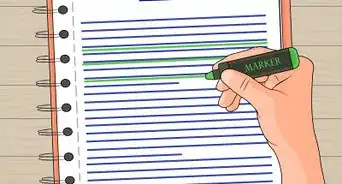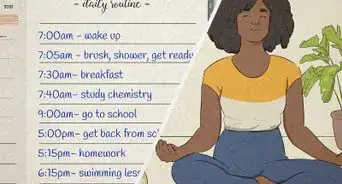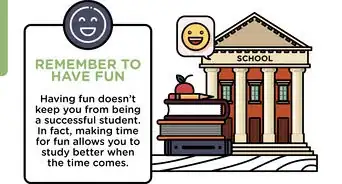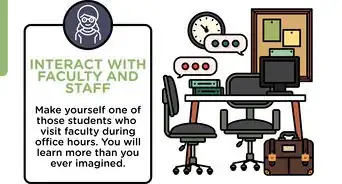This article was co-authored by Alexander Peterman, MA. Alexander Peterman is a Private Tutor in Florida. He received his MA in Education from the University of Florida in 2017.
There are 16 references cited in this article, which can be found at the bottom of the page.
wikiHow marks an article as reader-approved once it receives enough positive feedback. In this case, 81% of readers who voted found the article helpful, earning it our reader-approved status.
This article has been viewed 96,090 times.
Everyone learns a little bit differently. Some people learn best by listening, while others are visual learners. Most people learn best with a combination of learning styles. Whether you are a student or just someone trying to expand your knowledge base, identifying your learning style will show you how best to enhance your understanding of different topics.
Steps
Discovering Different Learning Styles
-
1Read about the different learning types. In order to figure out your learning style, it is important to understand the difference between the types of learners. There are many books and websites that you can use to research the topic.Head to your local library and ask the reference librarian. Or ask the guidance counselor at your school for some information.[1]
- Most people acknowledge that there are 7 different learning styles that are common: visual, auditory, verbal, physical, logical, social, and solitary. People often associate with several of these styles.
- Ask the guidance counselor at your school for some information. This person should be familiar with all of the styles.
-
2Try visual learning. After you do some research, start experimenting with different learning styles. It can be useful to try a new method of learning to figure out which one is your style. You can start with visual learning, which means that you learn by using pictures and other images.[2]
- Ask yourself if you rely on images to help you understand key topics. For example, when you are reading your Biology text, do you find the diagrams more helpful than the written content?
- Try adding more images into the topic you are learning. If you are studying for a history test, make a chart that illustrates the key topics. If this is helpful, you may be a visual learner.
- If you are a visual learner, you may find it easier to navigate using a map with markers rather than written directions.
Advertisement -
3Experiment with auditory learning. Aural, or auditory, means you learn effectively through sound and music. If you are not sure if this applies to you, spend some time adding sound to your study sessions. You could begin by reading select passages of your textbook out loud or listening to an audiobook to see if this helps you focus and understand the text.[3]
- If you need to hear something out loud in order to fully grasp the concept, you may be an auditory learner. Experiment by repeating key concepts to a classmate to see if hearing the material is useful to you.
- Do you find yourself talking while you read? That indicates auditory learning. Another clue that you are an auditory learner is if you often find yourself annoyed by pictures and the written word.
- During your next study session make up some rhymes to help you remember the material. For example, "President Carter would never barter with the Soviets." If this seems helpful, you are likely an auditory learner.
-
4Learn through words. Verbal learners are most comfortable with words, both spoken and written. If you are an avid reader, you are likely comfortable with verbal learning. Reading is one of the most effective ways for you to retain information.
- Ask yourself if you are most comfortable listening to a spoken lecture or presentation. Verbal learners often resist group projects or activities.
- When you study, do you make written outlines of the material? This is an indication that verbal learning is your preference.
-
5Use movement to learn. Kinaesthetic learning is another common type of learning style. Physical learners rely on their hands, sense of touch, and physical activity. Movement is key to retaining information for this style of learning.[4]
- If the thought of sitting through a lecture makes you nervous, you might learn better through physical activity. Do you fidget a lot? That is another sign.
- To find out whether you are a physical learner, try adding some movement to your routine. Try standing up while reading.
- Use as many physical objects as possible. Try making flashcards so that you can physically flip through the information.
-
6Investigate logic. Another learning style that you can experiment with is logical learning. Logical learners are puzzle solvers who prefer to use reasoning and systems to find answers. People who are good at math are often logical learners.[5]
- To determine whether you are a logical learner, try rearranging the way you think about material. Look at each individual part instead of just the whole picture.
- For example, if you are studying World War II, don't just think about who won the war. Spend time thinking about why and how.
- Making connections is one of the keys to logical learning. If it is your natural instinct to draw clear lines between different topics, you are likely a logical learner.
-
7Learn with others. Some people learn best when they are interacting with other people. Social learners learn best in groups or with at least one other person. If you prefer to work with others, you may be a social learner.[6] Many social learners have siblings or grew up in a home with lots of other people.
- Does the prospect of a group project make you excited? Do you dread studying by yourself? You likely lean towards social learning.
- To figure out whether social learning works for you, try forming a study group. Ask one or more classmates to join you after class to work through the material together.
- If other people often ask you for help with material, that is another indication that you are a social learner. People will notice that you like to discuss what you are learning.
-
8Practice solitary learning. Another common type of learning style is known as solitary learning. Solitary learners work best independently. If you are most effective without the help of others, you may be partial to this style.[7]
- Do you enjoy spending time reflecting on a topic? That is an indication that you are a solitary learner.
- Instead of trying to just memorize information, solitary learners like to sit back and take time to think about each aspect of the content.
- Solitary learners often like to make plans ahead of time. They also typically make individual goals for most aspects of life.
Identifying Your Learning Style
-
1Take several self-assessments. After you experiment with different learning styles, you can spend some time clarifying which style is best for you. This is a fast and simple way to determine your learning style. Many reputable websites offer online quizzes that will analyze your learning style based on your responses. Search the web for a reputable site, and take several quizzes, as it's common to get different results. This may indicate that you utilize several different learning styles.[8]
- Avoid sites that appear to be overtly selling a product. Look for a site such as HowToStudy.com that focuses on educational resources.
- Start the quiz. Be prepared to answer questions such as "What kind of book would you like to read for fun?" or "What are you most likely to do when waiting in line?"
- Most assessments are multiple-choice. They generally take between 5 and 20 minutes to complete.
- Remember that there are no right or wrong answers. Everyone learns a little differently, and that is okay.
-
2Reflect on your experiences. The results of your self-assessments can give you a good idea of which learning style(s) applies to you. However, it is important to take some time to think about your personal preferences. Think back on some of your most memorable learning experiences.[9]
- Maybe you vividly remember learning about the Civil War in elementary school. Was it because your teacher asked you to build a model of a canon? That might mean you are a physical learner.
- Perhaps high school English was your favorite class. Did it really make an impression when your teacher read Shakespeare aloud? You might be more of a verbal learner.
- Take what you know about yourself and combine it with the results of your self-assessment quizzes. This should give you a good indication of your learning style.
-
3Talk to an instructor. It can be helpful to get some additional feedback to determine your learning style. Talk to one of your current or past teachers. Ask if the instructor has some time to talk to you about your education.[10]
- Prepare some questions to ask. Try saying something such as, "Do you have any particular observations about the way I learn?"
- You can also ask, "Did you ever notice a topic or skill that I seemed to struggle with?"
- Ask the teacher for tips about how to improve your quality of learning. Talk to more than one person if possible.
-
4Put your findings to the test. Once you start to understand your learning style, you can tailor your educational experiences so that you can learn more quickly and easily. For example, if you believe that you are a visual learner, seek out images and pictures when first approaching a new topic. As you get to know yourself better, you'll figure out the best way for you to access and remember information.
- Maybe you are having trouble understanding the chapter you're reading in your biology textbook. If the paragraph on photosynthesis just doesn't make sense, try searching for online images. A chart or illustration might help cement the information.
- If you are an auditory learner, it can be hard to succeed in largely verbal subjects such as English. Try having a friend read aloud some passages to you of To Kill a Mockingbird.
- Perhaps you are trying to teach yourself a new skill, like knitting. If you are a physical learner, don't spend too much time becoming frustrated by reading a description of how to knit. Instead, pick up the needles and start learning with your hands.
Taking Advantage of Your Learning Style
-
1Study more effectively. Knowing your learning style can help you retain information in a more effective manner. If you choose the best way for your brain to learn, you will pick up on concepts more quickly. Arrange your study sessions around your learning style.
- Forming a study group can be helpful for many types of learning styles, except for solitary learners. Ask classmates to join you at a set time and location each week to work together. It's best to study with people who have a similar learning style to your own.
- Social learners learn best in group settings outside of school, too. For example, a social learner would do best to take a group cooking class rather than reading a cookbook.
- If you are a solitary learner, plan your study sessions for times when you know you will be alone. If necessary, work out a schedule with your roommates or family members to ensure you'll have the alone time that you need.
-
2Combine learning styles. Most people learn best by using a combination of learning styles. Don't be afraid to use different methods to approach one topic or lesson. Combining learning styles can really accelerate the rate at which you learn. [11]
- Use different methods to take notes. If a skill seems like it is best recalled with words, just paraphrase the lecture. But if a picture would help, don't hesitate to draw a diagram in your notes to help you process the information.
- If you are a verbal learner, you probably rely mostly on words. Sometimes, it can be helpful to use an alternate style.
- For example, if you are trying to learn to play the piano, you will definitely want to listen to recordings and practice getting a feel for the keys.
- Using a wide variety of resources may be more effective than limiting yourself to one learning approach. When teaching, try to give your students a lot of different ways of learning. For instance, in class you can do both group work and lectures, and for homework you can give students books and have them watch videos or read online. You can even have drop-in office hours in case a student has questions.[12]
-
3Use your senses. Once you have identified your learning style, you can begin using all of your senses to increase your knowledge. For example, if you are an auditory learner, you will learn to value your hearing. Try using a tape recorder to record lessons instead of just writing things down.[13]
- Physical learners learn best when moving. Try mentally reviewing your vocabulary list while going for a jog.
- You could also benefit from standing up when reading or writing. Physical learners retain more information when not sitting still.
- If you are a visual learner, try drawing a picture of any concept you want to master. You can also post sticky notes around your house with information. Seeing information regularly is key for you.
-
4Know your strengths. When you are trying to grasp a new concept, look for the most effective way to convey the information to your brain. Choose a method that fits your learning style. Don't be afraid to utilize more than one method.[14]
- If you are a solitary learner, find a quiet place to study. You can try a library or a coffee shop that isn't very busy.
- Challenge yourself to step outside your comfort zone. Supplement your solitary learning style by asking questions or comparing notes with a classmate.
- It's important to play to your strengths, but it's also a good idea to flex your mental muscles. You should occasionally try to switch up your method of learning. This is especially important so that you can learn well in multiple settings, including a traditional classroom. Though many teachers attempt to teach using various learning styles, it's important to be flexible so you can learn well in any setting.
-
5Learn more efficiently. Once you have identified your learning style, you will likely see a change in your mental capabilities. It will likely take you less time to learn a new concept. You will also likely retain information better.[15]
- If you adapt your habits to fit your learning style, you will eventually have to spend less time studying each topic. This doesn't mean you will spend less time learning--it just means you can learn more information in less time.
-
6Gain confidence. If you feel more comfortable learning new skills or information, you will be more confident. Confident learners tend to learn more quickly and effectively. You will be more likely to seek out new information.[16]
- Confident learners are more likely to speak up and ask questions. This is a great way to add to your knowledge base.
-
7Enhance your performance. Knowing your learning style can help outside of school, too. Use your knowledge to help improve your job performance. You will be able to become more productive and increase your value to your employer.
- Maybe you are a visual learner. If your job is in sales, make sure to track your output using charts and graphs. You'll be able to easier spot trends and ways to improve.
- If you are an auditory learner, ask your boss if she minds if you record your performance review. You can listen to the feedback again later and better absorb the information.
Community Q&A
-
QuestionI don't want to write. I want to read only. What do I do?
 Community AnswerAuditory learners learn best through listening with their ears. They don't take notes, and they best retain information through listening. If it's allowed, then auditory learners record spoken lectures in class, if recording devices are allowed. If you love reading, then you are probably a verbal learner. They learn best through reading, so you're probably a half auditory half verbal learner.
Community AnswerAuditory learners learn best through listening with their ears. They don't take notes, and they best retain information through listening. If it's allowed, then auditory learners record spoken lectures in class, if recording devices are allowed. If you love reading, then you are probably a verbal learner. They learn best through reading, so you're probably a half auditory half verbal learner. -
QuestionHow do I know about my students' learning style?
 Community AnswerObserve them while you are teaching. For example, if you are teaching them photosynthesis, some of them would draw a diagram of a plant/ they would write the key points/they might record your audio and lots more things.
Community AnswerObserve them while you are teaching. For example, if you are teaching them photosynthesis, some of them would draw a diagram of a plant/ they would write the key points/they might record your audio and lots more things. -
QuestionWhat are some tips for a visual and verbal learner?
 Community AnswerTry using flashcards, flowcharts and diagrams. Check out a channel by Ellen Kelley. She's a visual learner and she also explains about her various methods of studying.
Community AnswerTry using flashcards, flowcharts and diagrams. Check out a channel by Ellen Kelley. She's a visual learner and she also explains about her various methods of studying.
References
- ↑ https://bau.edu/blog/types-of-learning-styles/
- ↑ https://www.whitbyschool.org/passionforlearning/auditory-visual-and-kinesthetic-helping-children-succeed-through-different-learning-styles
- ↑ https://www.wgu.edu/blog/2020/08/auditory-learning-style.html
- ↑ https://www.houghton.edu/current-students/center-for-student-success/academic-support-and-accessibility-services/study-advisement/general-study-information/kinesthetic-learning-style/
- ↑ https://www.open.edu/openlearncreate/mod/page/view.php?id=152108
- ↑ https://materchristi.libguides.com/c.php?g=169439&p=1114549
- ↑ https://www.brightoncollege.edu/study-tips-for-solitary-learners/
- ↑ https://www.webtools.ncsu.edu/learningstyles/
- ↑ https://www.simplypsychology.org/learning-kolb.html
- ↑ https://www.umassd.edu/dss/resources/faculty-staff/how-to-teach-and-accommodate/how-to-accommodate-different-learning-styles/
- ↑ https://openstax.org/books/college-success/pages/2-4-learning-styles
- ↑ Nathan Fox, JD. Academic Tutor. Expert Interview. 15 November 2019.
- ↑ https://www.education.vic.gov.au/school/teachers/teachingresources/discipline/science/continuum/Pages/sensesworking.aspx
- ↑ https://www.understood.org/en/articles/different-learning-strengths-what-you-need-to-know
- ↑ https://help.open.ac.uk/emotional-intelligence
- ↑ https://www.cambridge.org/elt/blog/2019/04/26/5-ideas-develop-confident-learners/
About This Article
Discover your learning style by trying out different approaches to see which ones you like best, such as by drawing a picture of a concept to test out your visual learning abilities. If you take in more information by listening to a lecture or reading a book, you may be a verbal learner. Think about whether you learn more in a group setting or by yourself to decide if you're a social or solitary learner. For tips on combining learning styles, and how to take a test to find out what your style is, read on!



















































































